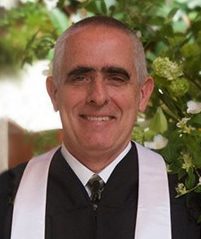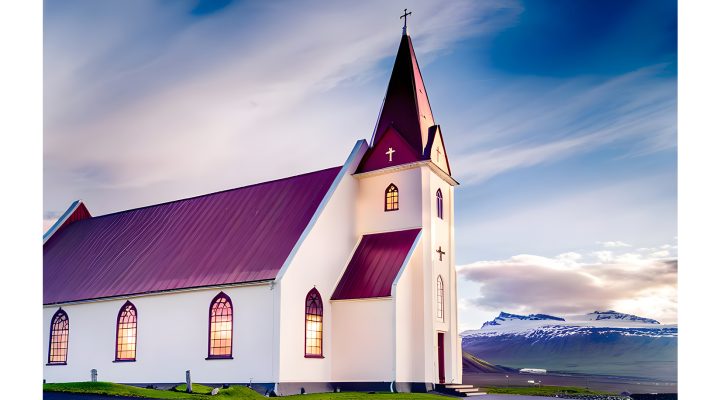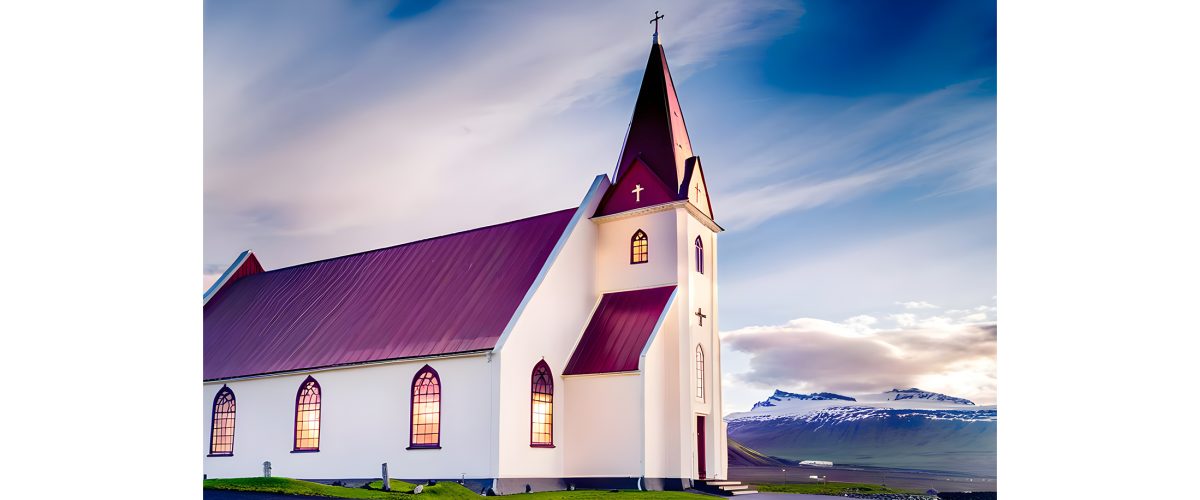Once upon a time, if anyone used the phrase “purple church,” they might well have been referring to the sanctuary during Advent and Lent; the church’s two annual liturgical waiting rooms, sacred seasons when altars and pastors are draped and dressed in purple paraments and stoles.
Nowadays, of course, when folk use the phrase “purple church,” it is far more likely they are speaking not liturgically but politically; as in, “Ours is a purple church, home to both Democrats and Republicans.” To borrow from the currently popular political color scheme, a “purple” church is neither “red” nor “blue” but both — purple.
Which, needless to say, is a good thing. After all, if every local church at its best is a small snapshot of the whole kingdom of God, where “every creature in heaven on earth, under the earth and in the sea” will someday sing together forever around the throne of God (Revelation 5:13), then every family of faith should hope to be home to a wide stream of diversity, a kind of congregational “unity in diversity” which has rarely been more needed or more difficult than now, election season 2024.

Chuck Poole
The kind of congregational unity that is capable of embracing political diversity rarely has been more needed than now for the same reason it rarely has been more difficult than now: because the political divide rarely has been more severe than it has become in the last decade — a partisan polarization rooted in the reality that there rarely has been an election season when so much was at stake in our national life.
Add to that the incessant ubiquity of our confirmation bias echo chambers of choice, and it may now be more difficult than ever for congregations to “just get along.” Or as Paul put it in his letter to the Philippians, to be “of one spirit and one mind.”
A century ago, William Butler Yeats’ poem “The Second Coming” framed in a different context that oft-quoted question “the purple church” now faces in new ways: “Can the center hold?”
Turning and turning in the widening gyre
The falcon cannot hear the falconer;
Things fall apart; the center cannot hold;
Mere anarchy is loosed upon the world,
The blood-dimmed tide is loosed,
and everywhere The ceremony of innocence is drowned;
The best lack all conviction, while the worst
Are full of passionate intensity.
“Can the center hold?” is one of the fundamental questions for “purple” churches.
“Must we sacrifice moral clarity and theological truth on the altar of congregational unity?”
If we keep the unifying center, at what price? Must we sacrifice moral clarity and theological truth on the altar of congregational unity?
All this may sound like so much irrelevant handwringing on the ears of those who are in politically “like minded” congregations — “red” churches or “blue” churches where almost everyone thinks and votes alike. But those who are in politically diverse “purple” churches know the level of care with which our words must be weighed, not only out of institutional concern but also out of genuine love, because everywhere we look in our politically, theologically, ideologically diverse “purple” family of faith, we see the image of God in very dear people of widely divergent, deeply held perspectives.
There is a certain holiness about that kind of diversity gathering weekly in a sanctuary; a beautifully Pentecostal kind of holiness about people who say the same about nothing on Monday singing the same about everything on Sunday; people who cancel out one another in the voting booth lifting up one another in the prayer circle, visiting one another in the hospital, embracing one another at the funeral.
So, how do we hold all that together without sacrificing clarity on the altar of unity or unity on the altar of clarity?
I can hear, somewhere in the background, the words of Emily Dickinson, who famously advised, “Tell all the truth, but tell it slant.” But as much as I revere Emily Dickinson, here I beg to differ. Our calling in the church is not to tell the truth “slant” but straight, in words the Quakers call “gentle and plain,” in the voice Marilynne Robinson calls “soft and serious.”
“While everyone is entitled to their own opinion, not every opinion is equally true to the spirit of Jesus.”
To borrow a phrase from the wisdom of William Sloane Coffin, “When you have something to say that is both painful and true, try to say it softly.” No eye-rolling sarcasm. No cute and clever snarkiness. No tactics or strategies. Nothing but truth, spoken in nothing but love.
But of course, even with all that meticulous care, still there remains what the famous 20th-century American poet Patty Loveless called “the trouble with the truth.” After all our most careful listening, gentle speaking and faithful dialoguing is done, still we are left with the truth that was embodied in the life of Jesus, whose words and works we glimpse in the Gospels; and the Holy Spirit leading us further and further in the ways the Jesus of the Gospels would go if Jesus were here. Which is where all this can sometimes become especially tender for the purple church, because while everyone is entitled to their own opinion, not every opinion is equally true to the spirit of Jesus.
We know that, like the rest of the Bible, the four Gospels are not the inerrant, infallible, final word of God. But if they are a trustworthy record of the words and works of Jesus, then, while we know that Jesus, a Middle Eastern Jew, would not be a Democrat or a Republican, an American or a Christian, we also know the Jesus of Matthew, Mark, Luke and John would condemn white supremacy, would want all immigrant people to be spoken of with dignity and treated with compassion and would call for every person to have equal access to health care without any social determinant impeding their path.
To read the four Gospels is to know the Jesus of those Gospels would not dehumanize gender nonconforming people or make it difficult for those who are gay to be who they are. To read the four Gospels is to know the Jesus of Matthew, Mark, Luke and John would work to shelter unhoused people, end food insecurity and get weapons of war off our streets.
“Reconciliation always takes sides, and the side reconciliation takes is justice.”
We love to say the ground at the foot of the Cross is level, and it is, but we must never confuse “level” with “neutral.” As Austin Channing Brown says in her remarkable memoir, I’m Still Here, “Reconciliation always takes sides, and the side reconciliation takes is justice.”
The same is so for the Jesus of the Gospels. Many of us want a Jesus who is neutral on the issues of the day. But let’s be honest: Does anyone who has read the four Gospels believe if Jesus were here today, the Jesus of Matthew 7:12, Matthew 22:34-40, Matthew 25:31-46, Luke 10:25-37 and Luke 14:12-14 would pretend to be neutral concerning racial injustice, xenophobia, misogyny, weapons of war on American streets, health care outcomes determined by financial incomes or mean-spirited culture war Christianity?
All of which can be a great conundrum for many in the church. We say, for good and important reasons, that we want the church to “stay out of politics.” But if the church is, in fact, the body of Christ, how can the church, whose only Lord is Jesus, be silent concerning the moral, gospel, public policy issues of the day?
A couple of years ago, as I prepared to retire, a young adult who had grown up in the church with me as his pastor said, “Even after all these years, I have no idea if you are a Democrat or a Republican.” He meant it as a compliment, which is how I received it. Partisanship has no place in the pulpit.
However, the fact that our congregation should not know if we are affiliated with one party or the other must never be conflated with the idea that the congregation should not know where we stand on the great moral justice questions of our time.
If there is no doubt about where the Jesus of the four Gospels would stand on an issue, then there should be no doubt about where we stand on that issue.
On the other hand, knowing what we know about the Jesus of the four Gospels, one imagines that Jesus’ arms reach the same for souls in both directions — left and right, liberal and conservative, blue and red; the Jesus of Matthew, Mark, Luke and John living as he died and dying as he lived, arms out as wide as the world, as far one way as the other.
Which may be at least a part of what it means for us to take up our cross and follow Jesus, to become as Paul said, “crucified with Christ,” our wingspan stretched as impossibly wide as the reach of Jesus.
In a painfully polarized, sadly siloed, red or blue world, our life together as purple as the bruises on the face of Jesus, and the wine in the cup from which we all drink, together as one.
Chuck Poole retired in 2022 after 45 years of pastoral life, during which he served churches in Georgia; North Carolina; Washington, D.C.; and Jackson, Miss. He has served as a visiting preacher and teacher on the campuses of multiple universities, seminaries and divinity schools. He was the founding teacher of the Wood Street Bible Class in Jackson, which he led for 21 years. The author of nine books, numerous published articles, one gospel song and the lyrics to three hymns, Chuck has served as a “minister on the street” and as an advocate for interfaith conversation and welcome. He and his wife, Marcia, now live in Birmingham, where he serves on the staff of Together for Hope.
Related articles:
Here’s HELP for navigating a ‘purple’ church in an election year | Opinion by Gregory Magruder
What the color chart teaches us about surviving in a ‘purple’ church | Opinion by Mark Wingfield
There is no center | Opinion by Mark Wingfield


